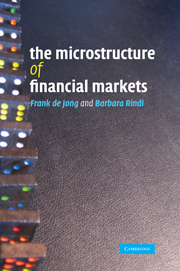Book contents
- Frontmatter
- Contents
- List of figures
- List of tables
- Preface
- Introduction
- 1 Institutions and market structure
- 2 Financial market equilibrium
- 3 Batch markets with strategic informed traders
- 4 Dealer markets: information-based models
- 5 Inventory models
- 6 Empirical models of market microstructure
- 7 Liquidity and asset pricing
- 8 Models of the limit order book
- 9 Price discovery
- 10 Policy issues in financial market structure
- Index
3 - Batch markets with strategic informed traders
Published online by Cambridge University Press: 05 June 2012
- Frontmatter
- Contents
- List of figures
- List of tables
- Preface
- Introduction
- 1 Institutions and market structure
- 2 Financial market equilibrium
- 3 Batch markets with strategic informed traders
- 4 Dealer markets: information-based models
- 5 Inventory models
- 6 Empirical models of market microstructure
- 7 Liquidity and asset pricing
- 8 Models of the limit order book
- 9 Price discovery
- 10 Policy issues in financial market structure
- Index
Summary
Introduction
There are three principal determinants of the bid–ask spread: fixed costs, adverse selection costs and inventory costs. Fixed costs are order processing costs, such as administrative costs and compensation for the market-maker's time. Adverse selection costs stem from asymmetric information. Finally, dealers must sustain the inventory costs of holding undesired portfolios of risky assets. By nature, only risk-averse dealers will be concerned with inventory costs, so the models that include them assume that liquidity providers are risk-averse. This assumption, which complicates the algebra, can be dispensed with in models with adverse selection.
The next two chapters are dedicated to models that focus on the adverse selection component of the bid–ask spread. Chapter 5 will also discuss inventory and fixed costs.
The model presented in this chapter draws on the work of Kyle (1985), who posits a group of risk-neutral market-makers facing insiders and liquidity traders. In fact, Kyle models the strategic interaction between an insider who chooses to trade in order to maximize his profits and a group of market-makers who take the insider's strategy into account in updating their beliefs on the future value of the asset and setting the equilibrium price. In this way, Kyle shows how information is incorporated into prices and how the latter reflect both the trading protocol where market-makers set prices and the strategic behaviour of the informed trader.
Even if the final outcome is a single equilibrium price, Kyle's model differs from the rational expectations protocol discussed in Chapter 2 in three ways.
- Type
- Chapter
- Information
- The Microstructure of Financial Markets , pp. 52 - 68Publisher: Cambridge University PressPrint publication year: 2009



